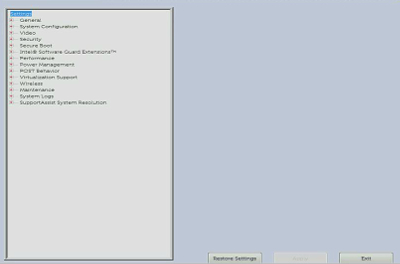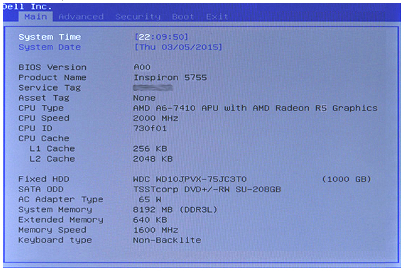Keyboard Troubleshooting and Usage: The Definitive Guide
Summary: See the Suggested Quick Fixes for a desktop or laptop keyboard not working and the keyboard troubleshooting sections for help with resolving your keyboard issues.
Instructions
Suggested Quick Fixes for a desktop keyboard not working.
- Reseat the USB cable or wireless USB receiver.
- When you have a wireless USB or Bluetooth mouse, install new batteries.
- Save any data, close any open programs, and restart the computer.
Suggested Quick Fixes for a laptop keyboard not working.
- Disconnect any external devices not needed to use the computer.
- Save any data, close any open programs, and restart the computer.
Perform a SupportAssist diagnostic on the keyboard
Duration: 00:58
When available, closed caption (subtitles) language settings can be chosen using the Settings or CC icon on this video player.
Select the tab below that matches the type of keyboard you have. Follow the steps on how to connect your keyboard to your computer.
- Locate the wireless USB receiver that came with your keyboard.
NOTE: Look in every compartment of the box that the device came in. The wireless USB receiver is small and can be overlooked. The receiver may have an informational pull tag that is attached to help you locate the receiver. If you bought the Keyboard and Mouse combination, the wireless USB receiver is placed in the wireless mouse USB storage compartment, and may have an informational pull tab attached. See the Dell Knowledge Base article Manuals and Documentation for your Dell Product for information about how to locate, and download, or view the manual for your Dell device to determine what is in the box the keyboard came in.
- Ensure that the keyboard is turned on.
NOTE: The power switch can be in one of several locations. See the Dell Knowledge Base article Manuals and Documentation for your Dell Product for information about how to locate, and download, or view the manual for your Dell device to locate the power switch.
- Insert the wireless USB receiver, as shown in Figure 1.
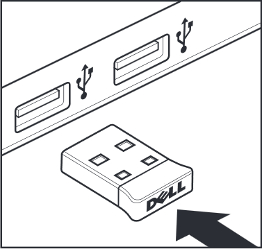
Figure 1: Wireless USB Receiver InsertionNOTES:- The receiver only goes in one way. When the connector does not seem to fit, adjust the angle, or flip it over.
- When using the receiver that came with the keyboard, no driver or configuration is needed for the keyboard to work.
See the Dell knowledge base article Guide For Pairing and Troubleshooting Dell Bluetooth Keyboards and Mouse for more information.
NOTE Some older receivers and keyboards may have a connect button; if so, press the connect button on the receiver and on the bottom of the keyboard. See the example in Figure 2.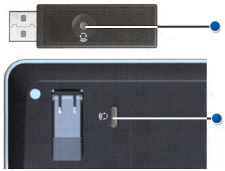
Figure 2: Wireless Keyboard Connect Button Location
- Look at the connector on the end of the USB keyboard cable.
- Look for a matching port and USB symbol on the laptop. For more information, see Figure 1.
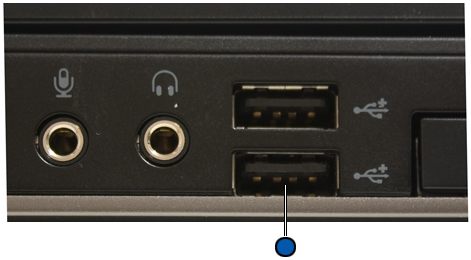
Figure 1: USB Port LocationsNOTES:- The connector only goes in one way. When the connector does not seem to fit, adjust the angle, or flip it over.
- No driver or configuration is needed for the keyboard to work.
For information about how to connect to your Bluetooth keyboard, see the Dell article Fix, Connect to and Learn About Bluetooth.
Select the tab below that matches the Operating System that is installed on your computer. Follow the steps to ensure that the settings are correct to prevent the cursor from moving around erratically while typing.

- In the Search box, type main.cpl.
- Touch or click main.cpl in the list of programs.
- Touch or click the Dell Touchpad tab.
NOTES:
When the Dell Touchpad tab is not listed, it means one of two things:
- The utility is not installed. In that case, see the Dell article Drivers and Downloads FAQs for more information about downloading drivers. The Dell Touchpad Driver or Utility is listed under Mouse, Keyboard & Input Devices.
- That your newer computer has a Precision Touchpad, to determine whether your computer has the Precision Touchpad, see the Dell article How to Use the Precision Touchpad Features in Windows 8(8.1) and 10, and then see the "The Cursor Moves Around Erratically While Typing on the Laptop Keyboard" section for instructions on how to change the settings, when necessary.
- Touch or click the image of the touchpad.
- Touch or click Sensitivity.
- Ensure that there is a checkmark in the Turn On box to the right of Touch Guard.
- Move the circle under Touch Guard all the way to the right (this can always be adjusted back if the setting is too high).
- Touch or click Save.
- Touch or click the X in the upper-right corner to close the Dell Touchpad Utility.
- Touch or click OK on the Mouse Properties window.
- Press and hold the Windows (
 ) key, and then press the q key.
) key, and then press the q key.
- In the Search box, type main.cpl.
- Click or touch main.cpl in the list of programs.
- Click or touch the Dell Touchpad or Cypress Trackpad tab.
NOTES:
When the Dell Touchpad or Cypress Trackpad tab is not listed, it means one of two things:
- The utility is not installed. In that case, see the Dell article Drivers and Downloads FAQs for more information about downloading drivers. The Dell Touchpad or Cypress Trackpad Driver or Utility is listed under Mouse, Keyboard & Input Devices.
- That your newer computer has a Precision Touchpad, to determine whether your computer has the Precision Touchpad, see the Dell article How to Use the Precision Touchpad Features in Windows 8(8.1) and 10, and see the "The Cursor Moves Around Erratically While Typing on the Laptop Keyboard" section for instructions on how to change the settings, when necessary.
For more information, see the Dell Touchpad Help and Support Page.
- Touch or click the image of the touchpad.
- Touch or click Sensitivity.
- Ensure that there is a checkmark in the Turn On box to the right of Touch Guard.
- Move the circle under Touch Guard all the way to the right (this can always be adjusted back if the setting is too high).
- Touch or click Save.
- Touch or click the X in the upper-right corner to close the Dell Touchpad or Cypress Trackpad Utility.
- Touch or click OK on the Mouse Properties window.
- Press the Windows (
 ) key.
) key.
- In the Search box, type main.cpl.
- Touch or click main.cpl in the list of programs.
- Touch or click the Dell Touchpad tab.
NOTE: When the Dell Touchpad tab is not listed, it means that the utility is not installed. See the Dell article Drivers and Downloads FAQs for more information about downloading drivers. The Dell Touchpad Driver or Utility is listed under Mouse, Keyboard & Input Devices.
- Touch or click the image of the touchpad.
- Touch or click Sensitivity or Touchpad Settings.
- Ensure that there is a checkmark in the Turn On or Enable box next to Touch Guard, Palm Check, or TouchCheck.
- Move the Touch Guard, Palm Check, or TouchCheck slider all the way to the right (this can always be adjusted back if the setting is too high).
- Touch or click Save or OK.
- Close the Dell Touchpad Utility.
- Touch or click OK on the Mouse Properties window.
- When your computer has a touch screen, the On-Screen Keyboard can be used until issues on your keyboard are resolved.
- When at the login-in screen, touch the Ease of Access icon
 , and then touch On-Screen Keyboard.
, and then touch On-Screen Keyboard. - From within Windows, touch or click the On-Screen Keyboard icon
 (located in the lower right corner.)
(located in the lower right corner.)
For more information, see the Microsoft Base article Use the On-Screen Keyboard (OSK) to type.
- When at the login-in screen, touch the Ease of Access icon
- Run the Keyboard Troubleshooter in Windows 11 or Windows 10.
- Press and hold the Windows (
 ) key, and then press the i key.
) key, and then press the i key.
- Select Update and Security.
- Select Troubleshoot from the left panel.
- Look for Keyboard in the Find and fix other problems section, and run the Troubleshooter.
- Press and hold the Windows (
- Connect an external keyboard from another computer, when available and browse to the Online Keyboard Diagnostics page.
NOTES:
- The test starts automatically.
- You may be prompted to install or update the SupportAssist program, if so, follow the prompts.
- The keyboard test is an interactive test, and you must press every key to test your keyboard thoroughly.
- Ensure to perform the test on the keyboard that is having the issue.
- Connect an external keyboard from another computer when available and run the integrated diagnostics. For more information, see the Dell article Resolve Hardware Issues With Built-in and Online Diagnostics (SupportAssist ePSA, ePSA, or PSA Error Codes).
NOTES:
- The test determines if the keyboard is detected at a hardware level below the Operating System. When it is detected, it means that the operating system or installed software is preventing the keyboard from working. You can use a restore point to return the operating system to a previous state when the keyboard worked (in Windows 11 or Windows 10, it is called refreshing the operating system). If that does not work, you may need to reinstall your operating system. For more information, see the Dell article How To Restore or Reinstall Microsoft Windows on a Dell Computer.
- When an error is reported during the test, write down the error and the validation code as seen. Then on another Internet device, browse to the SupportAssist Pre-Boot System Performance Check page to submit the issue.
- Ensure to perform the test on the keyboard that is having the issue.
- Ensure that the Number Lock Key is set correctly.
NOTES:
- For laptops that have a numeric keypad on the right side, it is by default turned on. When it is off, no numbers appear when the keys are pressed. Press the Number Lock Key to switch the numeric keypad on and off.
- Some laptops simulate a numeric keypad by using dual-purpose keys. When the Number Lock Key is active, numbers appear instead of letters when pressed. Press the num lock key to switch the numeric keypad on and off.
See the Dell article How to Obtain Manuals and Documentation for your Dell Product, for more information about where the Number Lock Key is.
- Turn off the computer.
- Unplug everything except the power cable, including the following:
- Speakers
- Printers
- Scanners
- USB devices
- USB flash drive or other external storage devices
- External monitor
- External keyboard
- External mouse
When your computer is attached to a docking station, undock it.
- Turn the computer back on and retest the keyboard. When the keyboard does work correctly, attach one device at a time, and test the keyboard to see which device may have caused the issue.
- Ensure that the BIOS is updated to the latest version. For more information, see the Dell article Dell BIOS Updates.
- When the keyboard still only works intermittently, see the instructions below that best match the issue you are having:
- When a specific key is not working or sticks, turn off the computer and use a can of compressed air to clean around the problem key and then retest the keyboard. For more information, see the How to Clean Your Keyboard section.
- When the issue only occurs in a specific application program, test the keyboard in another application program, such as Notepad. If the problem only occurs in a specific program, you must troubleshoot that specific program.
- When you have software that may change how the keyboard operates, uninstall or disable it, including:
- Keyboard macro programs
- External gaming keyboard software or drivers
- KVM (keyboard, video, mouse) switch software
- Try an external wired USB, wireless USB, or Bluetooth keyboard when available, to test if it responds correctly.
- When your computer has a touch screen, the On-Screen Keyboard can be used until issues on your keyboard are resolved.
- When at the login-in screen, touch the Ease of Access icon
 , and then touch On-Screen Keyboard.
, and then touch On-Screen Keyboard. - From within Windows, touch or click the On-Screen Keyboard icon
 (located in the lower right corner).
(located in the lower right corner).
For more information, see the Microsoft Base article Use the On-Screen Keyboard (OSK) to type.
- When at the login-in screen, touch the Ease of Access icon
- Run diagnostics on your keyboard, you can run the online version or integrated diagnostics (you need an external keyboard that is attached to start the diagnostics).
- Online diagnostics.
- Browse to the Online Keyboard Diagnostics page.
NOTES:
- The test starts automatically.
- You may be prompted to install or update the SupportAssist program, if so, follow the prompts.
- The keyboard test is an interactive test, and you must press every key to test your keyboard thoroughly.
- Ensure to perform the test on the keyboard that is having the issue.
- Browse to the Online Keyboard Diagnostics page.
- Integrated diagnostics.
See the Dell article Resolve Hardware Issues With Built-in and Online Diagnostics (SupportAssist ePSA, ePSA, or PSA Error Codes).
NOTES:- The test determines if the keyboard is detected at a hardware level below the Operating System. When it is detected, it means that the operating system or installed software is preventing the keyboard from working. You can use a restore point to return the operating system to a previous state when the keyboard worked (in Windows 11 or Windows 10, it is called refreshing the operating system). If that does not work, you may need to reinstall your operating system. For more information, see the Dell article How To Restore or Reinstall Microsoft Windows on a Dell Computer.
- When an error is reported during the test, write down the error and the validation code as seen. Then on another Internet device, browse to the SupportAssist Pre-Boot System Performance Check page to submit the issue.
- Ensure to perform the test on the keyboard that is having the issue.
- Online diagnostics.
- Reseat the USB cable into the computer.
- Ensure that the Number Lock Key is set correctly.
NOTE: The numeric keypad on a desktop keyboard is by default turned on. When it is off, no numbers appear when the keys are pressed. Press the Number Lock Key to switch the numeric keypad on and off.
For more information about where the Number Lock Key is, see the documentation that came with the keyboard or browse to the Keyboard and Mouse Manual page for the manual.
- Turn off the computer.
- Unplug any nonessential devices, including the following:
- Speakers
- Printers
- Scanners
- USB devices
- USB flash drive or other external storage devices
- Ensure that the BIOS is updated to the latest version. For more information, see the Dell article Dell BIOS Updates.
- Turn the computer back on and retest the keyboard. When the keyboard does work correctly, attach one device at a time, and test the keyboard to see which device may have caused the issue.
- When the keyboard still only works intermittently, see the instructions below that best match the issue you are having:
- When a specific key is not working or sticks, turn off the computer and use a can of compressed air to clean around the problem key and then retest the keyboard. For more information, see the How to Clean Your Keyboard section.
- When the issue only occurs in a specific application program, test the keyboard in another application program, such as Notepad. If the problem only occurs in a specific program, you must troubleshoot that specific program.
- When you have software that may change how the keyboard operates, uninstall or disable it, including:
- Keyboard macro programs
- External gaming keyboard software or drivers
- KVM (keyboard, video, mouse) switch software
- Try another wired USB, wireless USB, or Bluetooth keyboard when available, to test if it responds correctly.
- Run diagnostics on your keyboard. You can run the online version or integrated diagnostics (you need a known good keyboard that is attached to start the diagnostics).
- Online diagnostics.
- Browse to the Online Keyboard Diagnostics page.
NOTES:
- The test starts automatically.
- You may be prompted to install or update the SupportAssist program, if so, follow the prompts.
- The keyboard test is an interactive test, and you must press every key to test your keyboard thoroughly.
- Ensure to perform the test on the keyboard that is having the issue.
- Browse to the Online Keyboard Diagnostics page.
- Integrated diagnostics.
See the Dell article Resolve Hardware Issues With Built-in and Online Diagnostics (SupportAssist ePSA, ePSA, or PSA Error Codes).
NOTES:- The test determines if the keyboard is detected at a hardware level below the Operating System. When it is detected, it means that the operating system or installed software is preventing the keyboard from working. You can use a restore point to return the operating system to a previous state when the keyboard worked (in Windows 11 or Windows 10, it is called refreshing the operating system). If that does not work, you may need to reinstall your operating system. For more information, see the Dell article How To Restore or Reinstall Microsoft Windows on a Dell Computer.
- When an error is reported during the test, write down the error and the validation code as seen. Then on another Internet device, browse to the SupportAssist Pre-Boot System Performance Check page to submit the issue.
- Ensure to perform the test on the keyboard that is having the issue.
- Online diagnostics.
- Ensure to use the wireless USB receiver that came with your wireless keyboard. If you use a different USB receiver, the keyboard will need to be paired using the Dell Display and Peripheral Manager application. For more information, see the Dell Knowledge Base article Dell Display and Peripheral Manager for Windows.
Using another receiver may mean it uses a different technology that is not compatible with the keyboard. For details about the latest technology offered by Dell, see the same Dell Knowledge Base article above.
For products that are labeled Logitech
 , browse to the Logitech Downloads Site
, browse to the Logitech Downloads Site for drivers and software.
- Reinsert the batteries or install fresh batteries. For more information about how to install the batteries, see the document that came with the wireless keyboard or browse to the Keyboard and Mouse Manual page for the manual.
- Ensure that the keyboard is within 10 feet (3 meters) of the computer.
- Reseat the wireless USB receiver into the USB port.
- Ensure that the keyboard is turned on. See Figure 3 for an example of what the power button may look like. For more information about where the power switch is, see the document that came with the wireless keyboard or browse to the Keyboard and Mouse Manual page for the manual.
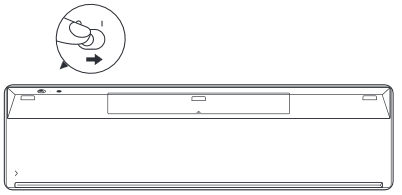
Figure 3: Power Button Example - Ensure that the Number Lock Key is set correctly.
NOTE: The numeric keypad on a desktop keyboard is by default turned on, but when it is off, no numbers appear when the keys are pressed. Press the Number Lock Key to switch the numeric keypad on and off.
For more information about where the Number Lock Key is, see the documentation that came with the wireless keyboard or browse to the Keyboard and Mouse Manual page for the manual.
- Save any data, close any open programs, and restart the computer.
- Some older receivers and keyboards may have a connect button. If so, press the connect button on the receiver and on the bottom of the keyboard. See Figure 4 for an example.
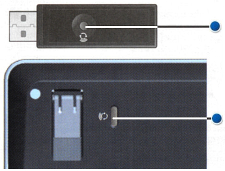
Figure 4: Wireless Keyboard Connect Button Location - Ensure that the BIOS is updated to the latest version. For more information, see the Dell article Dell BIOS Updates.
- When the keyboard still only works intermittently, see the instructions below that best match the issue you are having:
- When a specific key is not working or sticks, turn off the computer and use a can of compressed air to clean around the problem key and then retest the keyboard. For more information, see the How to Clean Your Keyboard section.
- When the issue only occurs in a specific application program, test the keyboard in another application program, such as Notepad. If the problem only occurs in a specific program, you must troubleshoot that specific program.
- When you have software that may change how the keyboard operates, uninstall or disable it, including:
- Keyboard macro programs
- External gaming keyboard software or drivers
- KVM (keyboard, video, mouse) switch software
- Connect the wireless USB receiver to an alternate USB port that is not next to an occupied port. If available try a USB port on a Dell monitor. A notice that drivers are being installed may appear; if so, wait until a message that the drivers were installed before using the keyboard.
NOTE: Some older wireless USB keyboards have a connect button, ensure to press the connect button on the receiver and on the bottom of the keyboard again.
- Try another external wired USB or wireless USB keyboard and receiver set when available. A notice that drivers are being installed may appear; if so, wait until a message that the drivers were installed before using the keyboard.
NOTE: Keyboards and mice are paired to a specific USB receiver. If you use a different USB receiver, then the keyboard with have to be paired using the Dell Display and Peripheral Manager application. For more information see Dell knowledge Base article Dell Display and Peripheral Manager for WindowsNOTE: When using an older wireless USB keyboard with a connect button, ensure to press the connect button on the receiver and on the bottom of the keyboard again.
- Run diagnostics on your keyboard, you can run the online version or integrated diagnostics (you need a known good keyboard that is attached to start the diagnostics).
- Online diagnostics.
- Browse to the Online Keyboard Diagnostics page.
NOTES:
- The test starts automatically.
- You may be prompted to install or update the SupportAssist program, if so, follow the prompts.
- The keyboard test is an interactive test, and you must press every key to test your keyboard thoroughly.
- Ensure to perform the test on the keyboard that is having the issue.
- Browse to the Online Keyboard Diagnostics page.
- Integrated diagnostics.
See the Dell article Resolve Hardware Issues With Built-in and Online Diagnostics (SupportAssist ePSA, ePSA, or PSA Error Codes).
NOTES:- The test determines if the keyboard is detected at a hardware level below the Operating System. When it is detected, it means that the operating system or installed software is preventing the keyboard from working. You can use a restore point to return the operating system to a previous state when the keyboard worked (in Windows 11 or Windows 10, it is called refreshing the operating system). If that does not work, you may need to reinstall your operating system. For more information, see the Dell article How To Restore or Reinstall Microsoft Windows on a Dell Computer.
- When an error is reported during the test, write down the error and the validation code as seen. Then on another Internet device, browse to the SupportAssist Pre-Boot System Performance Check page to submit the issue.
- Ensure to perform the test on the keyboard that is having the issue.
- Online diagnostics.
- Reinsert the batteries or install fresh batteries. For more information about how to install the batteries, see the documentation that came with the Bluetooth keyboard or browse to the Keyboard and Mouse Manual page for the manual.
- Ensure that the keyboard is within 10 feet (3 meters) of the computer.
- Ensure that the keyboard is turned on; see Figure 1 for an example of what the power button may look like. For more information about where the power switch is, see the documentation that came with the wireless keyboard or browse to the Keyboard and Mouse Manual page for the manual.
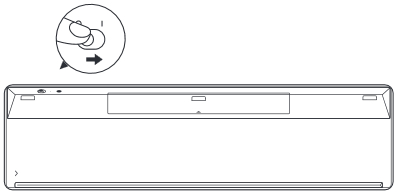
Figure 1: Power Button Example - Ensure that the Number Lock Key is set correctly.
NOTE: The numeric keypad on a desktop keyboard is turned on by default, but when it is off, no numbers appear when the keys are pressed. Press the Number Lock Key to switch the numeric keypad on and off.
For more information about where the Number Lock Key is, see the documentation that came with the Bluetooth keyboard or browse to the Keyboard and Mouse Manual page for the manual.
- Save any data, close any open programs, and restart the computer.
- Ensure that the BIOS is updated to the latest version. For more information, see the Dell article Dell BIOS Updates.
- When the keyboard still only works intermittently, see the instructions below that best match the issue you are having:
- When a specific key is not working or sticks, turn off the computer and use a can of compressed air to clean around the problem key and then retest the keyboard. For more information, see the How to Clean Your Keyboard section.
- When the issue only occurs in a specific application program, test the keyboard in another application program, such as Notepad. If the problem only occurs in a specific program, you must troubleshoot that specific program.
- When you have software that may change how the keyboard operates, uninstall or disable it, including:
- Keyboard macro programs
- External gaming keyboard software or drivers
- KVM (keyboard, video, mouse) switch software
- Install the latest Bluetooth drivers for your computer. For more information, see the Dell article How to Download and Install Dell Drivers
NOTES:
- The driver is located in the Network category.
- For additional drivers and software on products that are labeled Logitech
 , browse to the Logitech Downloads Site.
, browse to the Logitech Downloads Site.
- Re-pair the mouse to the computer. For this information and more on Bluetooth mice and keyboards, see the Dell article Fix, Connect to, and Learn About Bluetooth.
- Ensure that the Number Lock Key is set correctly.
NOTES:
- The numeric keypad on a desktop keyboard is by default turned on. When it is off, no numbers appear when pressed. Press the Number Lock Key to switch the numeric keypad on and off.
- For laptops that have a numeric keypad on the right side, it is turned on by default. When it is off, no numbers appear when the keys are pressed. Press the Number Lock Key to switch the numeric keypad on and off.
- Some laptops simulate a numeric keypad by using dual-purpose keys. When the Number Lock Key is active, numbers appear instead of letters when pressed. Press the Number Lock Key to switch the numeric keypad on and off.
See the Dell Knowledge Base article How to Obtain Manuals and Documentation for your Dell Product, for more information about where the Number Lock Key is.See the Dell Knowledge Base article Wrong Character Displayed Using Integrated Keyboard on a Dell Laptop for more information.
- Ensure that the keyboard language setting in Windows is correct (select the tab below that matches the Operating System that is installed on your computer for more information).
See the Microsoft article Manage the input and display language settings in Windows, for information about how to add and display additional languages.
- Ensure that the BIOS for your computer is up to date. For information about how to download the BIOS, see the Dell article Dell BIOS Updates.
- Using the SupportAssist application provides automatic computer updates and detects issues that are resolved for you. Let us take the effort out of maintaining your Dell Computer or Tablet. For more information about SupportAssist, browse to the Explore SupportAssist for Home PCs page.
 , and then select your Operating System and follow the instructions.
, and then select your Operating System and follow the instructions.
- Ensure that the BIOS for your computer is up to date. For information about how to download the BIOS, see the Dell article Dell BIOS Updates.
- Using the SupportAssist application provides automatic computer updates and detects issues that are resolved for you. Let us take the effort out of maintaining your Dell Computer or Tablet. For more information about SupportAssist, browse to the Explore SupportAssist for Home PCs page.
 , and then select your Operating System and follow the instructions.
, and then select your Operating System and follow the instructions.
- Ensure that the BIOS for your computer is up to date. For information about how to download the BIOS, see the Dell article Dell BIOS Updates.
- Using the SupportAssist application provides automatic computer updates and detects issues that are resolved for you. Let us take the effort out of maintaining your Dell Computer or Tablet. For more information about SupportAssist, browse to the Explore SupportAssist for Home PCs page.
There are four options to switch between the F1-F12 function and special keys that are on the top row of your Laptop keyboard.
- Single keystroke:
- Press and hold the Fn key (
 ) and then press the wanted function key to activate the special key that is associated with that function key.
) and then press the wanted function key to activate the special key that is associated with that function key.
- Press and hold the Fn key (
- Function Key Lock Toggle:
- Press and hold the Fn key (
 ), and then press the Escape key (
), and then press the Escape key (  ).
).
Pressing the function key activates the special key that is associated with that function key without having to press the Fn key first.
NOTE: Repeating the keystrokes returns the function keys to their normal state.
- Press and hold the Fn key (
- Change the Function key behavior in the BIOS:
- Restart or turn on the computer.
- When you see the Dell logo during POST, press the F2 key once a second to enter the System Setup.
NOTE: When the computer boots into Windows. Restart the computer and try again.
Depending on the type of BIOS (System Setup) your Dell computer has, the screen looks one of two ways.
Select the image that matches what is on your computer for information about how to set the Function keys default.
- On the BIOS (System Setup) screen, click Post Behavior.
- Click Fn Lock Options.
- Read the information as to what the options are, and make the wanted selection.
- Click Exit.
- Confirm saving the changes.
Your computer restarts now.
- On the BIOS screen, press the Right Arrow key until the Advanced menu is highlighted.
- Press the Down Arrow key until Function Key Behavior.
- Using the Up or Down arrows, select the wanted Function Key Behavior default, and press the Enter key.
- Press the Right Arrow key until the Exit menu is highlighted.
- Press the Down Arrow key until Exit Saving Changes or Save Changes (or similar wording) is highlighted, and then press the Enter key.
- Press the Enter key on Yes to Save Configuration (or similar wording).
Your computer restarts now.
- Windows Mobility Center:
- Press and hold the Windows (
 ) key, and then press the q key.
) key, and then press the q key. - In the Search box, type mobility center.
- Click Mobility Center in the search results.
- On the Windows Mobility Center screen, find the Function Key Row option. Using the drop-down menu, select the wanted option.
NOTE: There may not be a Function Key Row option depending on the version of your Operating System.
- Press and hold the Windows (
- Keyboard Shortcuts in Windows
- Internet Keys
- Multimedia Keys
- Laptop Keys
- Audio Cluster
- Audio Controls
- Sound Wheel
- Link to Keyboard Manuals
Keyboard Shortcuts in Windows
See the Microsoft Keyboard shortcuts in Windows 
- Press and hold the Fn key, and then press the b key.
- Press and hold the Ctrl key, then press and hold the Fn key, and then press the b key.
Internet Keys
For information about a button's action, locate it in Table 1.(Not all keyboards have every button that is shown.)
| Button | Action |
|---|---|
 |
Go to the Home Internet page. |
 |
Launch Email |
 |
Go to a web page or Web menu (configured by software). |
 |
Start Web Search |
Multimedia Keys
For information about a button's action, locate it in Table 2.(Not all keyboards have every button that is shown.)
| Button | Action |
|---|---|
 or or  |
Mute Sound |
 or or  |
Volume Down |
 or or  |
Volume Up |
 or or  |
Play/Pause |
 or or  |
Media Stop |
 or or  |
Previous |
 or or  |
Next |
 |
Audio Key (starts Windows Media Player) |
 |
CD/DVD Ejection Key - Quickset needs to be installed before this key works. (You may have to press and hold the Fn key first for it to work.) |
Laptop Keys
For information about a button's action, locate it in Table 3.(Not all keyboards have every button that is shown.)
| Button | Action |
|---|---|
 |
Number Lock (You may have to press and hold the Fn key first for it to work.) |
 |
Scroll Lock (You may have to press and hold the Fn key first for it to work.) |
 |
Brighten Display - Tap it to brighten the display. (You may have to press and hold the Fn key first for it to work.) |
 |
Dim Display - Tap it to dim the display. (You may have to press and hold the Fn key first for it to work.) |
 |
External Display - Pressing this key toggles between an external or internal monitor or both. (You may have to press and hold the Fn key first for it to work.) |
 |
CD/DVD Ejection - This key only works if Quickset is installed. (You may have to press and hold the Fn key first for it to work.) |
 |
Standby - This key only works if Quickset or Dell ControlPoint are installed, depending on your model. (You may have to press and hold the Fn key first for it to work.) |
 |
Battery Status - This key only works if Quickset or Dell ControlPoint are installed, depending on your model. (You may have to press and hold the Fn key first for it to work.) |
 |
Battery Charging - Allows you to disable battery charging until the next reboot. It does not affect battery usage and only works if Dell ControlPoint is installed. (You may have to press and hold the Fn key first for it to work.) |
 |
Fn Key - Fn stands for function. Pressing and holding this key allows you to access the alternative function of a key. It is typically located between the CTRL and the Windows key on the lower left of the keyboard. (The alternative function of the key may be in blue or red letters under the primary function. For more information, see the image above for descriptions of what the key does.) |
 |
Latitude ON:
|
 |
Disables or Enables the Touchpad on some computers. Press and hold the Fn key then press the F3 key to switch the Touchpad off or on. |
 |
Disables or Enables the Touchpad on some computers. Press only the F6 key to switch the Touchpad off or on. |
 |
Disables or Enables the Touchpad on some computers. Press the Touchpad Disable or Enable key (the key is located to the right of the F12 key) to switch the Touchpad off or on. |
Audio Cluster
When the buttons and knobs on your keyboard do not look like Figure 1, see the Audio Cluster or Sound Volume Wheel section.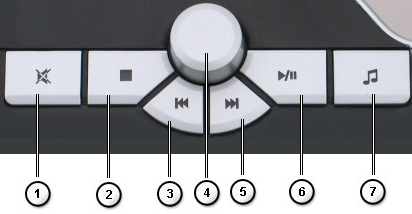
Figure 1: Audio Controls
| Numbers reference image above: | |
 |
Mute On or Off |
 |
Media Stop |
 |
Previous Track |
 |
Volume Knob - Volume Up or Volume Down (turns right to left, not a push-button). |
 |
Next Track |
 |
Play or Pause |
 |
Audio Key (starts Windows Media Player) |
Audio Controls
When the buttons and knobs on your keyboard do not look like Figure 2, see the Audio Controls or Sound Volume Wheel section.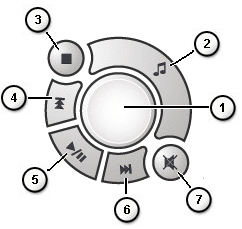
Figure 2: Audio Cluster
| Numbers reference image above: | |
 |
Volume Knob - Volume Up or Volume Down (turns right to left, not a push-button). |
 |
Audio Key (starts Windows Media Player) |
 |
Media Stop |
 |
Previous Track |
 |
Play or Pause |
 |
Next Track |
 |
Mute On or Off |
Sound Volume Wheel
When the buttons and knobs on your keyboard do not look like Figure 3, see the Audio Cluster or Audio Controls section.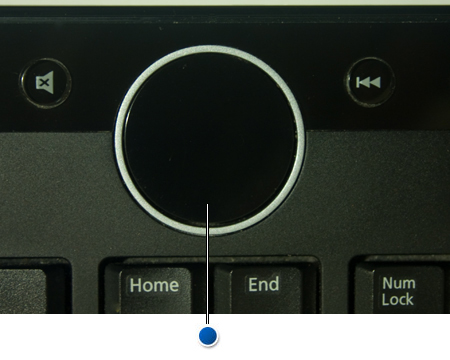
Figure 3: Sound Volume Wheel - Volume Up or Volume Down (turns right to left, not a push-button).
- Press and hold the Fn key (
 ), and then press the Backlit key (
), and then press the Backlit key (  ) to switch the keyboard light off and on.
NOTES:
) to switch the keyboard light off and on.
NOTES:- Look for the Backlit key first on the Function key row across the top of the keyboard. Otherwise, it may be in the lower-left side of the keyboard.
- When your computer does not have the Backlit key, your computer does not have this feature.
- For more information, see Dell article How to Troubleshoot the Backlit Keyboard on Your Dell Laptop Computer.
- Ensure that the computer is turned off.
- When using a wired, wireless, or Bluetooth keyboard, turn the keyboard upside down and shake it gently to remove any loose material.
- Use a vacuum cleaner designed for computers, when available.
- Use a can of compressed air to remove any additional loose material when available.
CAUTION: Do not turn the can on its side or upside down. This causes a freezing liquid to spray out and can damage your keyboard and skin.
- Using a Microfiber or terry cloth, wipe the keys and frame around the keys.
NOTE: When there is a build-up, take a cotton swab, microfiber towel, or terry cloth and dip it in isopropyl alcohol. It should be damp but not wet. Wipe away the build-up and let the isopropyl alcohol evaporate away before using the keyboard again.NOTE: When a single key or set of keys does not work there is no way to replace the keys individually, a replacement keyboard is the only option, Contact Technical Support for assistance.
For Windows 11 or Windows 10, perform the following steps:
- Press and hold the Windows (
 ) key, and then press the x key.
) key, and then press the x key.
- Select Settings.
- Select Time & Language.
- Select Keyboard.
- Select Language bar options.
- Select the Advanced Key Settings tab.
- Ensure that Press the CAPS LOCK key is selected.
- Select Apply, and then OK.
- Restart your computer.
For Windows 11, perform the following steps:
- Press and hold the Windows (
 ) key, and then press the x key.
) key, and then press the x key.
- Select Settings.
- Select Time & Language.
- Select Typing.
- Select Advanced Keyboard Settings.
- Select Language bar options.
- Select the Advanced Key Settings tab.
- Ensure that Press the CAPS LOCK key is selected.
- Select Apply, and then OK.
- Restart your computer.
When a keycap comes off, perform the following steps to try to put the keycap back on the laptop:
- Ensure the area that was under the keycap is clean. Using a can of compressed air is best.
CAUTION: Do not turn the can on its side or upside down. This causes a freezing liquid to spray out and can damage your keyboard and skin.
- Examine the plastic scissor spring that was under the keycap for any damage, as indicated by the red circles in Figure 1.
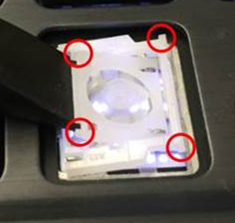
Figure 1: Scissor Spring Mechanism on a Laptop Internal Keyboard- When the plastic scissor spring looks intact, align the keycap, and gently press down to try to reseat the keycap. You must wiggle your finger back and forth so that the keycap is buckled down on the shear spring. There are two snaps, one at the top of the key and one at the lower part of the key.
CAUTION: Do not try to force the keycap back on, as you may damage other parts of the computer.
- When there is damage to the plastic scissor spring, the keycap cannot go back onto the keyboard.
NOTE: When you have purchased Accidental Damage coverage, or when a single key or combination of keys does not work there is no way to replace the keys individually, a replacement keyboard is the only option. Contact Technical Support for assistance. - When the plastic scissor spring looks intact, align the keycap, and gently press down to try to reseat the keycap. You must wiggle your finger back and forth so that the keycap is buckled down on the shear spring. There are two snaps, one at the top of the key and one at the lower part of the key.
When a keycap comes off, perform the following steps to try to put the keycap back on the keyboard:
- Ensure the area that was under the keycap is clean, a can of compressed air is best.
CAUTION: Do not turn the can on its side or upside down. This causes a freezing liquid to spray out and can damage your keyboard and skin.
- Examine the mechanism that was under the keycap for any damage.
- When the mechanism looks undamaged, align the keycap, and gently press down to try to reseat the keycap.
CAUTION: Do not try to force the keycap back on, as you may damage other parts of the keyboard.
- When there is damage to the mechanism, the keycap cannot go back onto the keyboard.
NOTE: When you have purchased Accidental Damage coverage, or when a single key or a set of keys does not work there is no way to replace the keys individually, a replacement keyboard is the only option. Contact Technical Support for assistance. - When the mechanism looks undamaged, align the keycap, and gently press down to try to reseat the keycap.
- In the Search box, type settings.
- In the list of programs, touch or click Settings.
- Touch or click Ease of Access.
- Touch or click Keyboard.
- Ensure the Turn on Filter Keys is set to off.
- Close the Settings window.
- Press and hold the Windows (
 ) key, and then press the q key.
) key, and then press the q key.
- In the Search box, type settings.
- In the list of programs, touch or click PC settings.
- Touch or click Ease of Access.
- Touch or click Keyboard.
- Ensure that the Filter Keys is set to off.
- Press the Windows (
 ) key to close the Settings window.
) key to close the Settings window.
- Press the Windows (
 ) key.
) key.
- In the Search box type, ease of access.
- Touch or click Ease of Access Center in the list of programs.
- Touch or click Make the keyboard easier to use.
- Ensure the checkbox to the left of Turn on Filter Keys is not checked.
- Touch or click Apply, and then OK.
- In the Search box, type settings.
- In the list of programs, touch or click Settings.
- Touch or click Ease of Access.
- Touch or click Keyboard.
- Ensure the Turn on Sticky Keys is set to off.
- Ensure the Turn on Toggle Keys is set to off.
- Close the Settings window.
- Press and hold the Windows (
 ) key, and then press the q key.
) key, and then press the q key.
- In the Search box, type settings.
- In the list of programs, touch or click PC settings.
- Touch or click Ease of Access.
- Touch or click Keyboard.
- Ensure that Sticky Keys is set to off.
- Ensure that the Toggle Keys is set to off.
- Press the Windows (
 ) key to close the Settings window.
) key to close the Settings window.
- Press the Windows (
 ) key.
) key.
- In the Search box type, ease of access.
- Touch or click Ease of Access Center in the list of programs.
- Touch or click Make the keyboard easier to use.
- Ensure the checkbox to the left of Turn on Sticky Keys is not checked.
- Ensure the checkbox to the left of Turn on Toggle Keys is not checked.
- Touch or click Apply, and then OK.
- Save any data, close any open programs, and restart the computer. When the mouse and keyboard do not respond at all, you may have to press and hold the power button down for at least 15 seconds to turn the computer off, and you lose any data that is not saved.
- Ensure that the BIOS is updated to the latest version. For more information, see the Dell article Dell BIOS Updates.
- Ensure that Windows has the latest updates. For more information, see the Microsoft article Windows Update: FAQ.
- Reseat the USB cable into the computer.
- Save any data, close any open programs, and restart the computer. When the mouse and keyboard do not respond at all, you may have to press and hold the power button down for at least 15 seconds to turn the computer off, and you lose any data that is not saved.
- Ensure that the BIOS is updated to the latest version. For more information, see the Dell article Dell BIOS Updates.
- Ensure that Windows has the latest updates. For more information, see the Microsoft article Windows Update: FAQ.
- Reseat the wireless USB receiver into the computer.
- Save any data, close any open programs, and restart the computer. When the mouse and keyboard do not respond at all, you may have to press and hold the power button down for at least 15 seconds to turn the computer off, and you lose any data that is not saved.
- Ensure that the BIOS is updated to the latest version. For more information, see the Dell article Dell BIOS Updates.
- Ensure that Windows has the latest updates. For more information, see the Microsoft article Windows Update: FAQ.
- Save any data, close any open programs, and restart the computer. When the mouse and keyboard do not respond at all, you may have to press and hold the power button down for at least 15 seconds to turn the computer off, and you lose any data that is not saved.
- Ensure that the BIOS is updated to the latest version. For more information, see the Dell article Dell BIOS Updates.
- Ensure that Windows has the latest updates. For more information, see the Microsoft article Windows Update: FAQ.
To disable the On-Screen Keyboard, perform the following steps.
- Press and hold the Windows (
 ) key, and then press the q key.
) key, and then press the q key.
- In the Search box, type ease of access center.
- Touch or click Ease of Access Center (Control Panel) from the list.
- Touch or click Use the computer without a mouse or keyboard.
- Ensure the box to the left of Use the computer without a mouse or keyboard is cleared.
- Touch or click Apply (when you have made changes).
- Touch or click OK.
- Close the Settings window.
To disable the On-Screen Keyboard, perform the following steps.
- Press and hold the Windows (
 ) key, and then press the q key.
) key, and then press the q key.
- In the Search box, type ease of access center.
- Touch or click Ease of Access Center (Control Panel) from the list.
- Touch or click Use the computer without a mouse or keyboard.
- Ensure the box to the left of Use the computer without a mouse or keyboard is cleared.
- Touch or click Apply (when you have made changes).
- Touch or click OK.
- Close the Settings window.
To disable the On-Screen Keyboard, perform the following steps.
- Press the Windows (
 ) key.
) key.
- In the Search box, type ease of access center.
- Touch or click Ease of Access Center from the list.
- Touch or click Use the computer without a mouse or keyboard.
- Ensure the box to the left of Use the computer without a mouse or keyboard is cleared.
- Touch or click Apply (when you have made changes).
- Touch or click OK.
- Close the Settings window.
- How to Troubleshoot USB Port When it is Not Working
- How to use the Dell Universal Pairing - This article provides information about which keyboard and mice are compatible with Dell Universal Pairing and how to connect them.
- Dell Bluetooth Wireless Keyboard and Mouse, Lock Up or Stop Working After a Restart
- Fix, Connect, and Learn about Bluetooth
- Learn How to Replace a Laptop Keyboard (with Bezel)

- For products that are labeled Logitech
 , browse to the Logitech Downloads Site for drivers and software.
, browse to the Logitech Downloads Site for drivers and software.
Using the SupportAssist application provides automatic computer updates and detects issues that are resolved for you. Let us take the effort out of maintaining your Dell Computer or Tablet. For more information about SupportAssist, browse to the Explore SupportAssist for Home PCs page.
How to Fix Dell Keyboard Not Working
Duration: 4:37
When available, closed caption (subtitles) language settings can be chosen using the Settings or CC icon on this video player.
How to Connect Bluetooth Device to your PC in Windows 11
Duration: 2:09
When available, closed caption (subtitles) language settings can be chosen using the Settings or CC icon on this video player.
USB Devices Not Working Windows 11 or Windows 10
Duration: 2:10
When available, closed caption (subtitles) language settings can be chosen using the Settings or CC icon on this video player.
